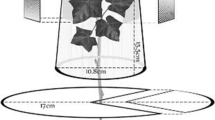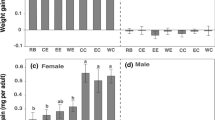Abstract
Neoseiulus womersleyi and N. californicus are two predators that are frequently used to control spider mites in fruit-tree orchards. Neoseiulus womersleyi used to be the dominant predator species in Japan, but since the 1990s in central and southwestern Japan, N. californicus populations have been increasing and have displaced populations of N. womersleyi. We previously observed the same phenomenon under laboratory conditions when these species were released at a 1:1 ratio, and attributed the displacement to asymmetrical intraguild predation. However, the ratio in fruit-tree orchards could be different from 1:1. Therefore, we hypothesized that differential susceptibilities to pesticides might accelerate species displacement of N. womersleyi by N. californicus, even if the ratio between these two species was extremely skewed in favor of N. womersleyi and no species displacement occurred otherwise. We examined the effects of 21 pesticides on egg-to-adult and adult survivorship in N. womersleyi and N. californicus. Among these pesticides, two neonicotinoids (acetamiprid and imidacloprid) had much severer effects on N. womersleyi than on N. californicus and thus could possibly account for the species displacement. When the two species were released onto leaf arenas at an N. californicus: N. womersleyi ratio of 1:9 in the absence of insecticide, no displacement was observed. However, just after acetamiprid or imidacloprid application, the proportion of N. californicus increased, causing N. californicus to displace N. womersleyi. Our results indicate that displacement in predator complexes of fruit-tree orchards could be due to different degrees of pesticide susceptibility.


Similar content being viewed by others
References
Abbott WS (1925) A method of computing the effectiveness of an insecticide. J Econ Entomol 18:265–267
Amano H (2001) Species structure and abundance of invertebrate natural enemies in sustainable agroecosystems. In: Shiomi M, Koizumi H (eds) Structure and function in agroecosystem design and management. CRC Press, New York, pp 167–182
Amano H, Ishii Y, Kobori Y (2004) Pesticide susceptibility of two dominant phytoseiid mites, Neoseiulus californicus and N. womersleyi, in conventional Japanese fruit orchards (Gamasina: Phytoseiidae). J Acarol Soc Jpn 13:65–70
Beers EH, Schmidt RA (2014) Impacts of orchard pesticides on Galendromus occidentalis: lethal and sublethal effects. Crop Prot 56:16–24
Beers EH, Brunner JF, Willet MJ, Warner GM (eds) (1993) Orchard pest management: a resource book for the Pacific Northwest. Good Fruit Grower, Yakima, WA. http://jenny.tfrec.wsu.edu/opm/
Beers EH, Brunner JF, Dunley JE, Doerr M, Granger K (2005) Role of neonicotinyl insecticides in Washington apple integrated pest management. Part II. Nontarget effects on integrated mite control. J Insect Sci 5:16
Braks MAH, Honorio NA, Lounibos LP, Lourenco-de-Oliveira R, Juliano SA (2004) Interspecific competition between two invasive species of container mosquitoes, Aedes aegypti and Aedes albopictus (Diptera: Culicidae), in Brazil. Ann Entomol Soc Am 97:130–139
Brown JK, Frohlich DR, Rosell RC (1995) The sweetpotato or silverleaf whiteflies: biotypes of Bemisia tabaci or species complex? Annu Rev Entomol 40:511–534
Chu D, Wan FH, Zhang YJ, Brown JK (2010) Change in the biotype composition of Bemisia tabaci in Shandong Province of China from 2005 to 2008. Environ Entomol 39:1028–1036
DeBach PE (1966) The competitive displacement and coexistence principles. Annu Rev Entomol 11:183–212
Dennehy T, Degain B, Harpold V, Zaborac M, Morin S et al (2010) Extraordinary resistance to insecticides reveals exotic Q Biotype of Bemisia tabaci in the New World. J Econ Entomol 103:2174–2176
Fungicide Resistance Action Committee (FRAC) (2016) FRAC Code List ©*2016: fungicides sorted by mode of action. http://www.frac.info. Accessed 20 Feb 2016
Gao Y, Reitz SR, Wei Q, Yu W, Lei Z (2012) Insecticide-mediated apparent displacement between two invasive species of leafminer fly. PLoS ONE 7:e36622
Gotoh T, Akizawa T, Watanabe M, Tsuchiya A, Shimazaki S (2005) Cold hardiness of Neoseiulus californicus and N. womersleyi (Acari: Phytoseiidae). J Acarol Soc Jpn 14:93–103
Gotoh T, Hanawa M, Shimazaki S, Yokoyama N, Fu C-Q, Sugawara R, Yano S (2014) Factors determining species displacement of related predatory mite species (Acari: Phytoseiidae). Exp Appl Acarol 63:205–215
Gröning J, Lücke N, Finger A, Hochkirch A (2007) Reproductive interference in two ground-hopper species: testing hypotheses of coexistence in the field. Oikos 116:1449–1460
Hochkirch A, Gröning J, Bücker A (2007) Sympatry with the devil: reproductive interference could hamper species coexistence. J Anim Ecol 76:633–642
Hogmire HW, Brown MW, Schmitt JJ, Winfield TM (1992) Population development and insecticide susceptibility of apple aphid and spirea aphid (Homoptera: Aphididae) on apple. J Entomol Sci 27:113–119
Horowitz AR, Denholm I, Gorman K, Cenis JL, Kontsedalov S, Ishaaya I (2003) Biotype Q of Bemisia tabaci identified in Israel. Phytoparasitica 31:94–98
Horowitz AR, Kontsedalov S, Khasdan V, Ishaaya I (2005) Biotypes B and Q of Bemisia tabaci and their relevance to neonicotinoid and pyriproxyfen resistance. Arch Insect Biochem Physiol 58:216–225
Insecticide Resistance Action Committee (IRAC) (2015) Mode of action classification 2015. Version 8. http://www.irac-online.org. Accessed 20 Feb 2016
Izawa H, Fuji K, Matoba T (2000) Control of multiple species of Lepidopterous insect pests using a mating disruptor and reduced pesticide applications in Japanese pear orchards. Jpn J Appl Entomol Zool 44:165–171. (in Japanese)
Ji J, Zhang Y-X, Wang J, Lin J-Z, Sun L, Chen X, Ito K, Saito Y (2015) Can the predatory mites Amblyseius swirskii and Amblyseius eharai reproduce by feeding solely upon conspecific or heterospecific eggs (Acari: Phytoseiidae)? Appl Entomol Zool 50:149–154
Kishimoto H (2002) Species composition and seasonal occurrence of spider mites (Acari: Tetranychidae) and their predators in Japanese pear orchards with different agrochemical spraying programs. Appl Entomol Zool 37:603–615
Lowery DT, Smirle MJ, Foottit RG, Beers EH (2006) Susceptibilities of apple aphid and spirea aphid collected from apple in the Pacific Northwest to selected insecticides. J Econ Entomol 99:1369–1374
Luo C, Jones CM, Devone G, Zhang F, Denholm I, Gorman K (2010) Insecticide-resistance in Bemisia tabaci biotype-Q from China. Crop Prot 29:429–434
McMurtry JA, De Moraes GJ, Sourassou NF (2013) Revision of the lifestyles of phytoseiid mites (Acari: Phytoseiidae) and implications for biological control strategies. Syst Appl Acarol 18:297–320
Mochizuki M (1990) A strain of the predatory mite Amblyseius longispinosus (Evans) resistant to permethrin, developing in the tea plantation of Shizuoka Prefecture (Acarina: Phytoseiidae). Jpn J Appl Entomol Zool 34:171–174. (in Japanese)
Palevsky E, Gerson E, Zhang Z-Q (2013) Can exotic phytoseiids be considered ‘wanted invaders’ in perennial cropping systems? Exp Appl Acarol 59:11–26
Parrella MP, Keil CB, Morse JG (1984) Insecticide resistance in Liriomyza trifolii. Calif Agric 38:22–23
Rao Q, Xu YH, Luo C, Zhang HY, Jones CM, Devine GJ, Gorman K, Denholm I (2012) Characterisation of neonicotinoid and pymetrozine resistance in strains of Bemisia tabaci (Hemiptera: Aleyrodidae) from China. J Integ Agr 11:321–326
Reitz SR, Trumble JT (2002) Competitive displacement among insects and arachnids. Annu Rev Entomol 47:435–465
Schausberger P (2003) Cannibalism among phytoseiid mites: a review. Exp Appl Acarol 29:173–191
Schausberger P, Walzer A (2001) Combined versus single species release of predaceous mites: predator–predator interactions and pest suppression. Biol Control 20:269–278
Schmidt-Jeffris RA, Beers EH (2015) Comparative biology and pesticide susceptibility of Amblydromella caudiglans and Galendromus occidentalis as spider mite predators in apple orchards. Exp Appl Acarol 67:35–47
Sun D-B, Liu Y-Q, Qin L, Xu J, Li F-F, Liu S-S (2013) Competitive displacement between two invasive whiteflies: insecticide application and host plant effects. Bull Entomol Res 103:344–353
Suzuki N, Osawa N, Nishida T (2012) Asymmetric reproductive interference between specialist and generalist predatory ladybirds. J Anim Ecol 81:1077–1085
Szczepaniec A, Creary SF, Laskowski KL, Nyrop JP, Raupp MJ (2011) Neonicotinoid insecticide imidacloprid causes outbreaks of spider mites on elm trees in urban landscapes. PLoS ONE 6:e20018
Tsueda H, Tsuchida K (2011) Reproductive differences between Q and B whiteflies, Bemisia tabaci, on three host plants and negative interactions in mixed cohorts. Entomol Exp Appl 141:197–207
Wakabayashi H (2000) Utilization of predacious phytoseiid mites in control of spider mites on fruit trees in Nagano prefecture. Jpn Agric Technol (Kongetsu-no-nogyo) 44(5):113–119 (in Japanese)
Wang ZY, Yan HF, Yang YH, Wu YD (2010) Biotype and insecticide resistance status of the whitefly Bemisia tabaci from China. Pest Manag Sci 66:1360–1366
Yuan LZ, Wang SL, Zhou JC, Du YZ, Zhang YJ, Wang JJ (2012) Status of insecticide resistance and associated mutations in Q-biotype of whitefly, Bemisia tabaci, from eastern China. Crop Prot 31:67–71
Zhang Y-X, Ji J, Lin J-Z, Chen X, Saito Y (2014) Female performance towards offspring under starved conditions in four phytoseiid species (Acari: Phytoseiidae). Exp Appl Acarol 65:29–41
Acknowledgments
We thank Dr. Koichi Goka (NIAES), Dr. Yasuki Kitashima (Ibaraki University) and Mr. Reo Sugawara (Ibaraki University) for their valuable suggestions on this study. We are also thankful to Dr. Hirotsuna Hoshi (Fukushima Agricultural Technology Center) for providing us with useful information.
Author information
Authors and Affiliations
Corresponding author
Rights and permissions
About this article
Cite this article
Ullah, M.S., Hanawa, M. & Gotoh, T. Pesticide-mediated displacement of a phytoseiid predator, Neoseiulus womersleyi, by another phytoseiid predator, N. californicus (Acari: Phytoseiidae). Exp Appl Acarol 69, 453–464 (2016). https://doi.org/10.1007/s10493-016-0053-2
Received:
Accepted:
Published:
Issue Date:
DOI: https://doi.org/10.1007/s10493-016-0053-2




